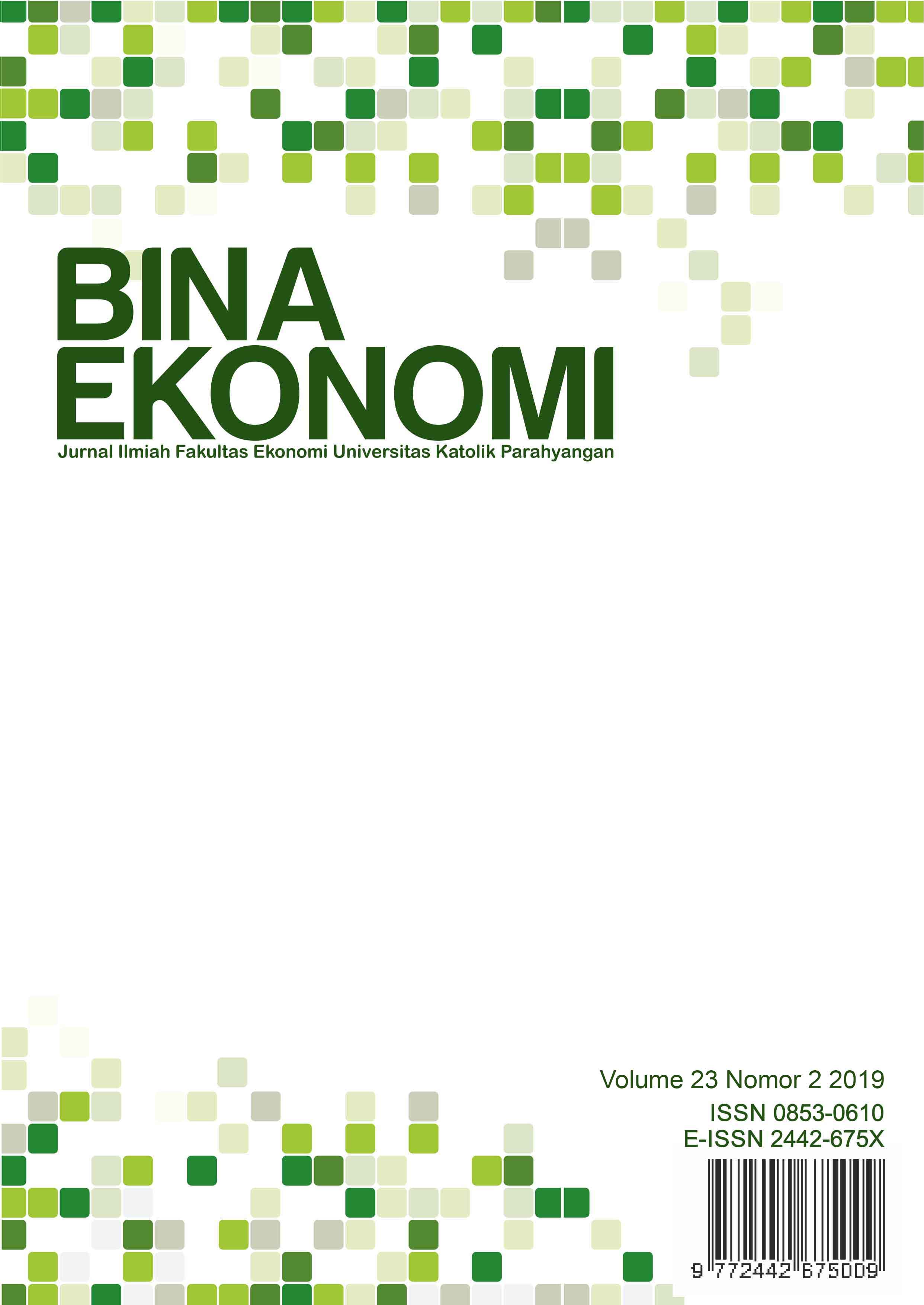Tindak Pidana Korupsi Dan Aktivitas Underground Economy
DOI:
https://doi.org/10.26593/be.v23i2.4251.78-102Abstract
Special and continuous attention need to be paid to the phenomenon of underground economic activities, especially in deciding the determination of this economic activities to decrease, monitor, and prevent phenomena that are adverse to national/regional income. The aims of this study are to analyze the activities and the potential for corrupt behavior of the underground economic agents, looking to avoid the tax revenues and implications on interest prices from underground economic activities. The method used for this research is a Explanatory Sequential Mix Methods, first analyzed quantitatively by formulating an equation model and applied using the purposefully selected method. The findings of the study showed that corruptive behavior in the underground economic activities has a positive influence on the amount of money supplied in narrow terms (M1-currency) from the regional levels in the 3T (foremost-outermost-underdeveloped) region. Increased corruption levels can boost the amount of money circulating in society. During most of the higher tax collection, the supply of money will increase (M1). It is necessary to implement pentahelix elements to build a synergy between actors and to begin implementing and mastering electronic/digital systems with E-Government systems in every financial transaction.
Keywords: Underground economy; narrow money; tax on revenue; sequential explanatory methods; corruption
References
Afdi, M., & Purnomo, K. (2015). underground economy activities in Indonesia. 65608. https://mpra.ub.uni-muenchen.de/65608/1/MPRA_paper_65608.pdf
Alamsyah, W., Abid, L., & Sunaryanto, A. (2018). Laporan Tren Penindakan Kasus Korupsi Tahun 2018. Indonesia Corruption Watch (ICW), 1–33. https://antikorupsi.org/sites/default/files/laporan_tren_penindakan_kasus_korupsi_2018.pdf
Amoh, J. K., & Adafula, B. (2019). An estimation of the underground economy and tax evasion: Empirical analysis from an emerging economy. Journal of Money Laundering Control, 22(4), 626–645. https://doi.org/10.1108/JMLC-01-2019-0002
Asaminew, E. (2010). The Underground Economy and Tax Evasion in Ethiopia : Implications for Tax Policy. Macroeconomic Division Ethiopian Economic Policy Research Institute, 1–26. http://www.csae.ox.ac.uk/conferences/2011-edia/papers/130-asaminew.pdf
Azwar, & Mulyawan, andi wawan. (2017). Analisis Underground Economy Indonesia dan Potensi Penerimaan Pajak. Jurnal Info Artha, vol 1 no 1, 60–78.
Badulescu, A. (2011). The underground economy: What is the influence of the discount factor? African Journal of Business Management, 5(16), 7050–7054. https://doi.org/10.5897/AJBM11.1192
Basuki, A. T. (2017). Pengantar Ekonometrika. Danisa Media.
Creswell. (2014). Research Design : qualitative, quantitative and mixec methods approaches. SAGE Publications Inc.
Creswell, J. W. (2010). Research Design : John W. Creswell. In Research design : Qualitative,Quantitative and Mix Methods Approaches. (second edi). SAGE Publications Inc.
Departemen Statistik Bank Indonesia. (2019). Analisis Uang Beredar Desember 2019. 1–5. https://www.bi.go.id/id/publikasi/perkembangan/Pages/M2-November-2018.aspx
Faal, E. (2003). Currency Demand, the Underground Economy, and Tax Evasion: The Case of Guyana. IMF Working Papers, 03(7), 1. https://doi.org/10.5089/9781451842432.001
Fathul, L. (2014). Siaran Pers OJK Tetapkan Batas Atas Suku Bunga Dana Perbankan. Otoritas Jasa Keuangan, September, 1. Siaran Pers OJK Tetapkan Batas Atas Suku Bunga Dana Perbankan.html
Feige, E. L. (1990). Defining and estimating underground and informal economies: The new institutional economics approach. World Development, 18(7), 989–1002. https://doi.org/10.1016/0305-750X(90)90081-8
Furuoka, F., & Munir, Q. (2014). Unemployment and Inflation in Malaysia: Evidence from Error Correction Model. Philippone Journal of Development, 1(1), 35–45.
Herlina wa ode, et. al. (2015). Strategi Pengembangan Usaha Sektor Informal dalam Meningkatkan Pendapatan Pedagang Kaki Lima di Kecamatan Kambu Kota Kendari. 125–134.
Kanao, Koji, H. dan, & Shigeyuki. (2010). The size of the underground economy in Japan. Munich Personal RePec Archive, 24064.
Kementerian Keuangan Republik Indonesia. (2019). APBN Kita : Kinerja dan Fakta. In kementrian keuangan republik indonesia. https://www.kemenkeu.go.id/publikasi/apbn-kita/
Kiani, M., Ahmed, A., & Zaman, K. (2015). Combining qualitative and quantitative approaches for measuring underground economy of Pakistan. Quality and Quantity, 49(1), 295–317. https://doi.org/10.1007/s11135-013-9987-1
Kristianto, A. H. (2019). Analyzing The Influence Of Interest Rates on Money Demand According to Keynesian Theory. Msdj Shanti Bhuana, 1(1), 38–47.
Kristianto, A. H., & Nurchayo, A. C. (2020). Potret Kondisi Perekonomian Indonesia. Amerta Media.
Mazhar, U., & Méon, P. G. (2017). Taxing the unobservable: The impact of the shadow economy on inflation and taxation. World Development, 90. https://doi.org/10.1016/j.worlddev.2016.08.019
Melnick, R., & Sokoler, M. (1984). The Government Revenue From Money Creation and The Inflationary Effects of a Decline in The Rate of Growth of GNP. Journal of Monetary Economics, 13.
Nizar, M. A. (2015). Potensi penerimaan pajak dari underground economy di indonesia. Kajian Ekonomi Dan Keuangan, 15, 1–38. https://doi.org/1410-3249
Nurunnabi, M. (2019). Political Influence and Tax Evasion in Bangladesh: What Went Wrong? 26, 113–134. https://doi.org/10.1108/s1058-749720190000026007
Ouédraogo, I. M. (2017). Governance, Corruption, and the Informal Economy. Modern Economy, 08(02), 256–271. https://doi.org/10.4236/me.2017.82018
Ozsahin, S., & Ucler, G. (2017). The consequences of corruption on inflation in developing countries: Evidence from panel cointegration and causality tests. Economies, 5(4). https://doi.org/10.3390/economies5040049
Pravasanti, Y. A. (2018). Dampak Kebijakan dan Keberhasilan Tax Amnesty bagi Perekonomian Indonesia. Kompartemen: Jurnal Ilmiah Akuntansi, 16(1), 84–94. https://doi.org/10.30595/kompartemen.v16i1.2415
Rahmani, T., & Yousefi, H. (2010). Corruption, Monetary Policy, and Inflation: A Cross-Country Examination.
Rasbin. (2013). Ekspektasi Potensi Underground Economy di Indonesia. Kajian, 18(3), 229–239. https://doi.org/https://doi.org/10.22212/kajian.v18i3.493
Rothenberg, A. D., Gaduh, A., Burger, N. E., Chazali, C., Tjandraningsih, I., Radikun, R., Sutera, C., & Weilant, S. (2016). Rethinking Indonesia’s Informal Sector. World Development, 80, 96–113. https://doi.org/10.1016/j.worlddev.2015.11.005
Samimi, A. J., & Abedini, M. (2012). Control of Corruption and Inflation Tax: New Evidence From Selected Developing Countries. Procedia - Social and Behavioral Sciences, 62, 441–445. https://doi.org/10.1016/j.sbspro.2012.09.072
Samuda, S. J. A. (2016). Underground Economy in Indonesia. Buletin Ekonomi Moneter Dan Perbankan, 19(1), 39–56. https://doi.org/10.21098/bemp.v19i1.599
Schneider, F., & Hametner, B. (2014). The shadow economy in Colombia: Size and effects on economic growth. Peace Economics, Peace Science and Public Policy, 20(2), 293–325. https://doi.org/10.1515/peps-2013-0059
Tanzi, V., & Fund, I. M. (2014). The Shadow Economy , Its Causes and Its Consequences. International Seminar on the Shadow Economy Index in Brazil,” Brazilian Institute of Ethics in Competition, July.
Williams, C. C., & Horodnic, I. A. (2017). Evaluating the relationship between social exclusion and participation in the informal sector in the European Union. International Journal of Manpower, 38(3), 489–503. https://doi.org/10.1108/IJM-10-2015-0179
Yakubu, M., Umar, U., & Bello, Z. A. (2014). Relationship between money supply and government revenues in Nigeria. CBN Journal of Applied Statistics, 5(2), 117–136.


